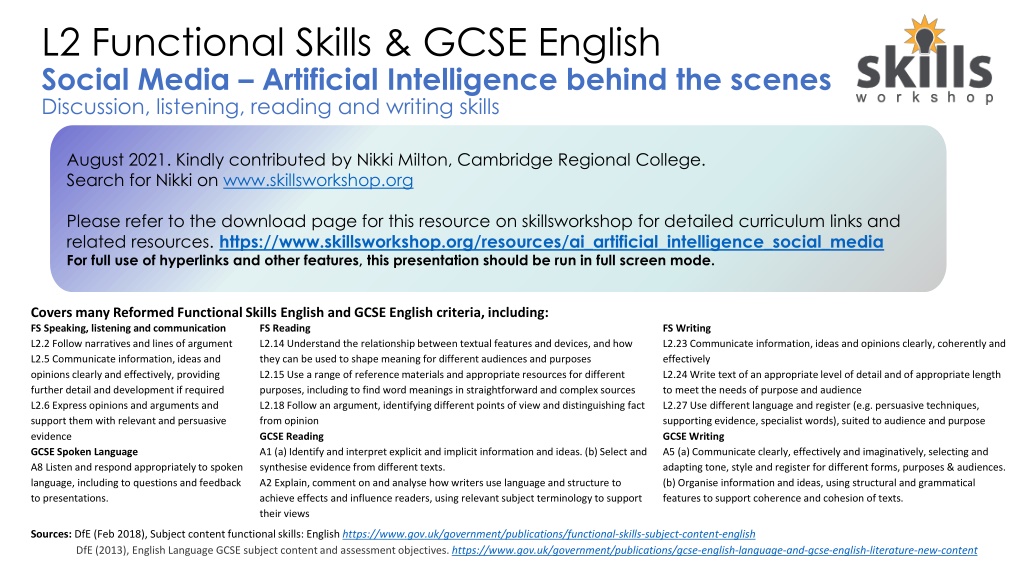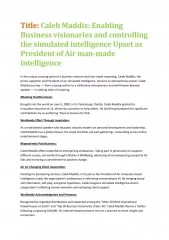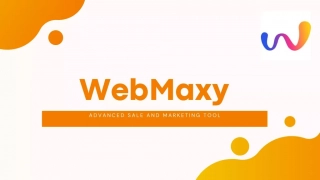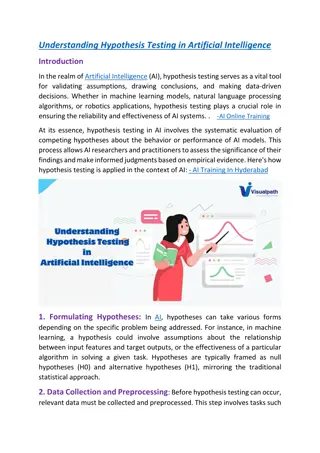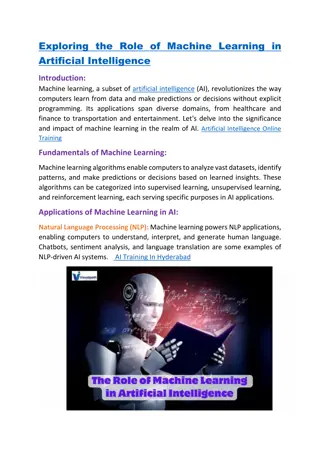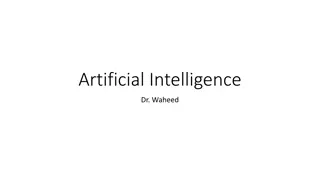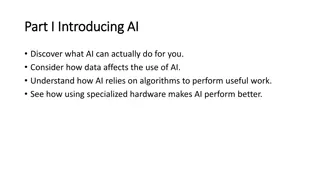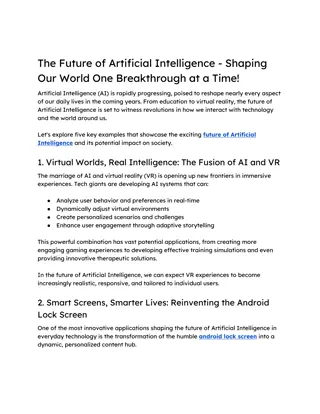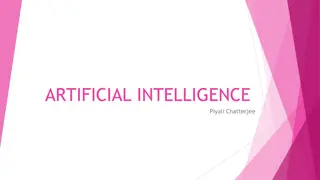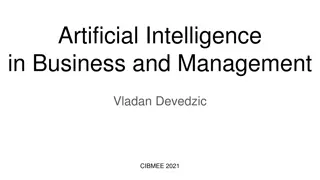Social Media and Artificial Intelligence: Behind the Scenes Discussion
Explore the impact of social media on our daily lives with over 3.6 billion global users spending an average of 2 hours and 25 minutes daily. Uncover the facts behind social media statistics and delve into the nuances of AI surveillance in the digital age, prompting reflection on the modern social dilemma.
Download Presentation

Please find below an Image/Link to download the presentation.
The content on the website is provided AS IS for your information and personal use only. It may not be sold, licensed, or shared on other websites without obtaining consent from the author. Download presentation by click this link. If you encounter any issues during the download, it is possible that the publisher has removed the file from their server.
E N D
Presentation Transcript
Description: swlogo L2 Functional Skills & GCSE English Social Media Artificial Intelligence behind the scenes Discussion, listening, reading and writing skills August 2021. Kindly contributed by Nikki Milton, Cambridge Regional College. Search for Nikki on www.skillsworkshop.org Please refer to the download page for this resource on skillsworkshop for detailed curriculum links and related resources. https://www.skillsworkshop.org/resources/ai_artificial_intelligence_social_media For full use of hyperlinks and other features, this presentation should be run in full screen mode. Covers many Reformed Functional Skills English and GCSE English criteria, including: FS Speaking, listening and communication L2.2 Follow narratives and lines of argument L2.5 Communicate information, ideas and opinions clearly and effectively, providing further detail and development if required L2.6 Express opinions and arguments and support them with relevant and persuasive evidence GCSE Spoken Language A8 Listen and respond appropriately to spoken language, including to questions and feedback to presentations. FS Reading L2.14 Understand the relationship between textual features and devices, and how they can be used to shape meaning for different audiences and purposes L2.15 Use a range of reference materials and appropriate resources for different purposes, including to find word meanings in straightforward and complex sources L2.18 Follow an argument, identifying different points of view and distinguishing fact from opinion GCSE Reading A1 (a) Identify and interpret explicit and implicit information and ideas. (b) Select and synthesise evidence from different texts. A2 Explain, comment on and analyse how writers use language and structure to achieve effects and influence readers, using relevant subject terminology to support their views FS Writing L2.23 Communicate information, ideas and opinions clearly, coherently and effectively L2.24 Write text of an appropriate level of detail and of appropriate length to meet the needs of purpose and audience L2.27 Use different language and register (e.g. persuasive techniques, supporting evidence, specialist words), suited to audience and purpose GCSE Writing A5 (a) Communicate clearly, effectively and imaginatively, selecting and adapting tone, style and register for different forms, purposes & audiences. (b) Organise information and ideas, using structural and grammatical features to support coherence and cohesion of texts. Sources:DfE (Feb 2018), Subject content functional skills: English https://www.gov.uk/government/publications/functional-skills-subject-content-english DfE (2013), English Language GCSE subject content and assessment objectives. https://www.gov.uk/government/publications/gcse-english-language-and-gcse-english-literature-new-content
Social Media AI behind the scenes How many people use social media? Social media as we know it was born in 2004 when MySpace reached a million monthly active users (Our World in Data, 2019). Sixteen years have passed, and in 2020 we had over 3.6 billion people using social media globally (Statista, 2021). This equals about 49% of the total global population. However, as big as this number sounds, the usage of social media hasn t peaked yet. Social media 4.66 billion people around the world use the internet and there are currently 3.6 billion social media users worldwide. 2021 statistics published by Data Reportal stated that On average, people spend 2 hours and 25 minutes on social media each day . Fact finding Can you identify 3 facts on this slide? How do we know that they are facts? #WatchingYou Text Source: https://sixads.net/blog/social-media-marketing-statistics/#12_Top_social_media_statistics Video Source: https://www.youtube.com/watch?v=uaaC57tcci0
Key Vocabulary #WatchingYou Social Media AI behind the scenes You re Being Watched: Can We Escape The Social Dilemma We re In? For some time now, we ve been living in a binary world the real-world and the world of the internet. Today, one can google an address, a question, a person anything really and they have the answer in a matter of seconds; and with the help of social media platforms, one can associate with and reach out to anyone in the world at any point in time. It all seemed hunky-dory until experts and civil society members started questioning the dark side of technology and social media usage. binary hunky-dory Artificial Intelligence (AI) attention extraction algorithms If You re Not Paying For The Product, Then YOU Are The Product AI is also capable of advancing those algorithms on their own, which may or may not be understood by the staff who created the whole model in the first place how scary is that? The former staff of tech giants featured in the movie highlight the fact that if you re not paying for the product, then you are the product particularly with regard to social media platforms. A wide range of surveillance tools and means are being used to target the right audience, and Artificial Intelligence (AI) is creating a better , and more personalised experience for users with the help of algorithms fed to them, that try to keep users glued to their screens all the time. What do they mean? What do the following quotes mean? Can you identify the language techniques used? 1. if you re not paying for the product, you are the product 2. users glued to their screens Netflix s The Social Dilemma shows us the horrors of social media, how it traps us and feeds on our insecurities. Writing Task Write a web forum entry expressing your views about the use of AI behind the scenes. How do you feel about the idea of being watched and encouraged to be glued to your screen ? Did someone just comment on my photograph? I got a notification! Hey, a friend just invited me to like a new page these are all attention extraction hoots to make people continue checking their devices over and over again like somebody who s after a jackpot at a casino. Include at least two language features and either a semi-colon, a question mark or an exclamation mark. Text Source: https://www.thequint.com/voices/opinion/netflix-the-social-dilemma-facebook-instagram-addiction-dangers-surveillance-google-manipulation-artificial-intelligence#read-more
#WatchingYou Social Media AI behind the scenes What is DeepMind? DeepMind are a team of scientists, engineers, ethicists and more, committed to solving intelligence, to advance science and humanity. Intelligence allows us to learn, imagine, cooperate, create, communicate, and so much more. By better understanding different aspects of intelligence, we can use this knowledge as inspiration to build novel computer systems that learn to find solutions to difficult problems on their own. Like the Hubble telescope that helped us look deeper into space, these tools are already expanding human knowledge and making positive global impact. Think. Pair. Share Key Vocabulary What do you think the Pros and cons are for using artificial intelligence (AI) within social media? ethicists novel DeepMind s long term aim is to solve intelligence, developing more general and capable problem- solving solutions, known as artificial general intelligence (AGI). Hubble telescope Discuss in pairs and be prepared to share with the class. Text Source: https://deepmind.com/ Video Source: https://www.youtube.com/watch?v=MuWWZ91-G6w
#WatchingYou Social Media AI behind the scenes Google Autocomplete Autocomplete is especially useful for those using mobile devices, making it easy to complete a search on a small screen where typing can be hard. For both mobile and desktop users, it s a huge time saver all around. How much? Well: On average, it reduces typing by about 25% Cumulatively, we estimate it saves over 200 years of typing time per day. Yes, per day! Predictions, not suggestions Autocomplete is a feature within Google Search designed to make it faster to complete searches that you re beginning to type. What comes next? You ll notice Google call these autocomplete predictions rather than suggestions , and there s a good reason for that. Autocomplete is designed to help you complete a search they were intending to do, not to suggest new types of searches to be performed. These are Google s best predictions of the query you were likely to continue entering. Copy and complete these sentence starters. Keep your answers to yourself. 1. I am great at _______________. 4. I wish I was_____________. 2. Why am I always ____________? 5. The purpose of life is to ___. 3. I wish people would stop ______. 6. When will it_____________? How do Google determine these predictions? Google looks at the real searches that happen on Google and show common and trending ones relevant to the characters that are entered and also related to your location and previous searches . Google Autocomplete in Real Life How did your answers compare to those given in the video? What are your thoughts about Google Predictions? Do you think they are more predictions or suggestions? The predictions change in response to new characters being entered into the search box. As you type more letters, predictions can disappear and new predictions will appear at the top of the list. Text Source: https://blog.google/products/search/how-google-autocomplete-works-search/ Video Source: https://www.youtube.com/watch?v=HJOYUcdLGFc
#WatchingYou Social Media AI behind the scenes Are Smartphones making us dumber? While peer group pressure and social expectations are behind most smartphone purchases, many parents also hope that these clever devices will encourage their child to learn to be tech-savvy, to develop their creative skills and to use these tiny computers to boost their learning. Neuroscience Research shows that smartphones are making us stupider, less social, more forgetful, more prone to addiction, sleepless and depressed, and poor at navigation so why are we giving them to kids? The school introduced a bring your own device (BYOD) policy so we had to buy them an iPad. I was just like: We shouldn t be doing this. It s not good for them. Professor Mark Williams presented some of the latest research on the phenomenon in a special Sydney science week presentation in 2019 titled: Are Smartphones Making us Dumb? Smartphones are linked to reduced social interaction, inadequate sleep, poor real-world navigation and depression. Smartphones make us antisocial. Smartphones make us forgetful. Smartphones mess with our sense of direction. Smartphones make us sleepless, friendless and depressed. There s lots of evidence showing that information you learn on a digital device, doesn t get retained very well and isn t transferred across to the real world, he says. You re also quickly conditioned to attend to lots of attention-grabbing signals, beeps and buzzes, so you jump from one task to the other and you don t concentrate. But growing evidence shows that smartphones are doing the reverse: rather than making us smarter, mobile devices reduce our cognitive ability in measurable ways. Writing task Pick either writing task a or b and write a paragraph. Make use of at least two language features and either an exclamation mark, or a semi-colon or a dash. Key Vocabulary a) Write a paragraph arguing that smartphones make us dumber. b) Write a paragraph arguing that smartphones make life easier and information more accessible. cognitive phenomenon Neuroscience Text Source: https://lighthouse.mq.edu.au/article/august-2019/smartphones-are-making-us-stupid-and-may-be-a-gateway-drug
Social Media AI behind the scenes #MonsterAI The link between Mary Shelley s Frankenstein and AI There is an indisputablelink between Victor Frankenstein s creation (let s try and veer away from the term monster), and Artificial Intelligence. Key Vocabulary indisputable Prometheus Mary Wollstonecraft Shelley s narrative of the modern Prometheus has travelled through time and space, surpassing generations. For me, the classic tale of Frankenstein and his creation is timeless in the true sense of the word. It cannot be bolted down. Borne from growing scientific circles of the Victorian era and the mind of an intellectually advanced teenage girl, it boasts post-modern sensibilities and futuristic ideals. There was a huge preoccupation with science fiction during this time. Reflective of the rapid progress in early industrial, technological and scientific advancements. Darwin s Theory of Evolution (1859) challenged faith in the Church. Questioning the fabric of what the majority of people at the time believed in creation and life itself. Frankenstein plays on these fears. A scientist playing god, a man creating a super-intelligent being a being capable of things beyond human ability. It s now, more relevant than ever, 200 years on. preoccupation Singularity ethical None but those who have experienced them can conceive of the enticements of science in scientific pursuit there is continual food for discovery and wonder. -Victor Frankenstein The questions Shelley raises about a man-made being are relevant in the creation of AI. It explores the possibilities of Artificial General Intelligence and fears of the Singularity. There are many ethical concerns that link Frankenstein and AI too. You are my creator, but I am your master -Mary Shelley (1818) Group Discussion Research 1. In Groups of 3 or 4, share your findings from your research and how the faith of the church has been challenged by Darwin s Theory of Evolution (1859) Discuss whether AI also challenges the faith of the church. Be prepared to share your arguments for/against with the rest of the class. Research Darwin s Theory of Evolution (1859) and write a paragraph or two explaining why you believe it challenged faith in the church. 2. Text Source: https://bigcloud.global/the-link-between-mary-shelleys-frankenstein-and-ai/
#MonsterAI Social Media AI behind the scenes Where Frankenstein and AI Meet Key Vocabulary In the introduction to Frankenstein, Shelley speaks of her nightmare inspiration. I saw the hideous phantasm of a man stretched out, and then, on the working of some powerful engine, show signs of life, and stir with an uneasy, half vital motion. Frightful must it be; for supremely frightful would be the effect of any human endeavour to mock the stupendousmechanism of the Creator of the world. The iconography of artificial, man-made beings coming to life, rising up from the slab , has been replicated time and time again. Shows like Westworld, for example, have brought this trope to a new audience. phantasm stupendous iconography trope embodiment It is our duty to ensure that the production of Artificial Intelligence is done so in an ethical and moral way. We need to confront the issues surrounding algorithmic bias and discrimination head-on. Many AI professionals and companies are already, and AI ethics have become a huge talking point and area of interest. The way in which Artificial Intelligence will shape our future is unknown. However, through works like Shelley s, we are able to experience, reflect, and explore our future before it happens. Whilst Artificial Intelligence is a technological pursuit, There could be a future where an AI holds consciousness and thought processing power far greater than humans. Shelley explores this way before the development of Machine Learning. Frankenstein s creation learns language, and how to speak through a hole in a cottage wall where he secretly watches a family interact with one another. He is the very embodiment of machine intelligence. He learns like an algorithm throughout the novel. algorithmic poignant What are they saying? What does each of these quotations suggest about AI? time and time again talking point AI versus us? Give two quotations that compares AI to human beings. Like his creation, AI is not inherently good or evil. It is how we build it and how we use it that will shape its very being. What predictions would you make about the future of AI? Text Source: https://bigcloud.global/the-link-between-mary-shelleys-frankenstein-and-ai/
#MonsterAI Social Media AI behind the scenes Literary AI Mash Up Key Vocabulary The robot Shelley, who isn t really a robot, but actually an artificial intelligence developed by researchers at the Massachusetts Institute of Technology (MIT). In October 2017, Shelley began posting on Twitter the start of a horror story, and inviting users to continue it. vignettes prolificness Over to you In pairs or groups of three, choose one of Shelley s efforts below and continue the story in a round-robin collaborative writing exercise. So, in the time-honoured question directed at any writer, where does Shelley get her ideas? No lofty explanations of the author s craft here; Shelley has been trained to scour the Reddit online community sub-forum /r/nosleep, where users share their own spooky stories. I was standing right across the street, when a ghost stood behind me. I was so scared I couldn t move. I couldn t move. I wasn t able to move my eyes, I was screaming. Learning the language of terror, Shelley named and gendered for the godmother of horror, Frankenstein author Mary Shelley puts together eerie little vignettes and, crucially, aims to continue them from the replies posted by Twitter users in a kind of round-robin collaborative writing exercise. My body was pulled into the room by the presence of someone who was standing somewhere in the hallway. I looked around once and there they were, standing in the corner of the room, as they stared at me, unmoving. The screen flickered, and everything went black. I closed my eyes, and sat up. The darkness had subsided, and the page was the same as the one before, and the one in the middle of the message. I clicked the link, and the first few minutes, then black. I woke up this morning, screaming and crying. With a new story started every hour, you certainly can t doubt her prolificness. But are the stories actually any good? Text Source: https://www.theguardian.com/books/booksblog/2017/oct/31/horror-fiction-ai-collaboration-shelley-mit
